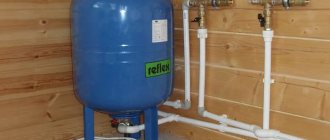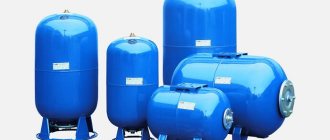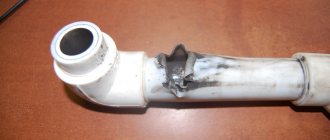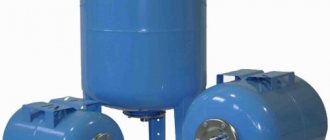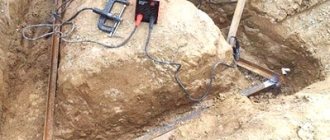Home / Heating
Back
Published: 12/18/2020
Reading time: 3 min
0
1407
The question of what is the difference between a hydraulic accumulator and an expansion tank remains unclear to some consumers, although such equipment has been used in boiler houses for quite a long time.
Water supply and heating systems cannot be imagined without such successful additions; most people are accustomed to distinguishing these devices by their shade.
One of the units is available in blue, and the other in red, but their structure has its own nuances. I want to analyze in detail the differences between the devices and describe the purpose of installing each type of device.
- 1 Design and purpose of the expansion tank
- 2 Design and purpose of the hydraulic accumulator
- 3 What are the differences 3.1 How does the expansion tank work
- 3.2 How a hydraulic accumulator works
What is the difference between a hydraulic accumulator and an expansion tank?
Tanks used in heating or hot water supply systems are more correctly called expansion tanks.
Hydraulic accumulators, in turn, are used in cold water supply systems.
In this case, a heating tank is needed to reduce the pressure resulting from the thermal expansion of water, and in the water supply, on the contrary, to increase it and raise the weak pressure to a comfortable value. In other words, their task is to somehow maintain the desired pressure of the working environment.
In both cases, pressure regulation is carried out using an elastic membrane and an air chamber in which the gas is under pressure and tends to fill the entire volume of the housing. The type of this membrane is also one of the differences between expansion tanks and hydraulic accumulators.
Differences between tanks by type of membrane
Tanks can have one of two types of membrane: pear-shaped or diaphragm. It is important to distinguish between them since using a tank with an unsuitable design significantly reduces its service life.
The diaphragm (disc-shaped) membrane cuts the body in half and does not isolate the coolant from the metal body. Membranes of this type do not tolerate proximity to the pump and cannot be repaired if they fail. When they break, the entire tank must be replaced, but on the other hand, they are cheaper and, if used correctly, last longer, since the diaphragm distributes the load of the working environment more evenly.
The pear-shaped membrane is attractive primarily because it can be replaced independently if it fails. However, due to its shape and fastening, the load on the membrane is distributed unevenly, which is an additional wear factor. It is mounted inside the housing using a special holder and fixed with a flange.
Moreover, this type of membrane can be used both in a hydraulic accumulator and in the design of an expansion tank. But the requirements for them are different. For the first, the suitability of the membrane material for drinking water is important. For the second, it is important to maintain the required temperature of the working environment.
Why you need to know how to select a hydraulic tank
In order for the equipment to function well and provide water to the residents of the house, you need not only to know what a hydraulic accumulator is for water supply systems, but also how to choose it correctly.
If the storage volume is insufficient, the pump will work in enhanced mode in order to provide the necessary pressure in the network.
If the volume of the hydraulic tank is excessive, there will be no such problem; in addition, there will always be a certain amount of water in the tank, which can be used, for example, in the event of a power outage. But you shouldn’t chase the size, because the main purpose of the equipment is to maintain pressure to distribute liquid in the network. And to store water, you can choose another, less expensive tank, for example, made of plastic.
Each thing has its own purpose - an ordinary plastic container is better suited for storing water “in reserve” Source gidrosnab.ru
What is a hydraulic accumulator?
From the name of the hydraulic accumulator you can guess that it is used primarily to store water, but it also performs other functions. For example, it dampens water hammer and smoothes out pressure fluctuations that occur during pump operation. In addition, it reduces the number of pump starts, which can significantly extend its life.
The operating cycle of the accumulator is simple: the pump pumps water into it and turns off when the pressure on the relay reaches the maximum permissible value. The next turn on of the pump occurs when, as a result of water intake, the pressure on the relay drops to the value set as the minimum.
It is important to note: since drinking water is used as the working medium in such a system, it should not come into contact with metal parts of the housing, which may rust.
In addition, the membrane in the accumulator must be more wear-resistant than in the expansion tank due to significantly more intense deformation and close placement of the pump.
Causes of breakdowns and ways to eliminate them
Despite the fairly strong and durable design, it happens that the water supply accumulator fails. There are several reasons for this. Very often the water main becomes airy. An air lock forms in the pipeline, preventing normal water circulation. The cause of airing in the water supply system is the accumulation of air inside the membrane. It gets there along with the flow of water, and gradually accumulates, spreading through the pipeline.
In hydraulic tanks with a vertical installation method, a special drain nipple is installed in their upper part to bleed the air accumulated in the membrane. Small storage tanks with a volume of less than 100 liters are usually made horizontally. Bleeding air into them can be somewhat more difficult.
The procedure here is performed in several stages:
- The hydraulic accumulator is disconnected from the power supply.
- All water is drained from the system until the storage tank is completely empty.
- Then all valves in the pipeline system are closed.
- The hydraulic tank is connected to electricity and refilled with water.
The air accumulated inside the storage tank will leave along with the discharged water.
What is an expansion tank in a heating system?
Its name also speaks for itself; it is designed to compensate for the thermal expansion of water in hot water supply and heating systems . The absence of an expansion tank in closed systems would inevitably lead to exceeding the maximum permissible pressure and leaks even with a slight increase in temperature.
If water with a temperature of 0 °C is heated to 100 °C, its density will become less, causing its volume to increase by about 4.3%. Without taking into account the deformation of pipes and other elements of the system, an increase in temperature by one degree increases the pressure by 3 bar.
The expansion tank must be able to operate in high temperature conditions. In addition, it must be of sufficient size to accommodate all excess coolant volume. As a rule, this is about 15-20% of the total coolant volume at room temperature.
What is the difference between a blue expansion tank and a red one?
Often, by the red or blue color of the tank, you can determine whether it is designed to work with a cold or hot working environment. However, the color of the tank depends solely on the preferences of the manufacturer and can be anything. For example, in Arma Shop we sell ProTank tanks (Turkey), painted gray. They are universal and can be used both as expansion tanks and hydraulic accumulators.
Models with bodies of various volumes are available for purchase: from 2 to 10,000 liters. If necessary, you can choose a model with a pump platform and a pressure gauge. Tanks are also available in vertical or horizontal mounting position.
Connection features
The connection of the hydraulic accumulator to the water supply system is determined by its installation point. When operating the equipment, there should be no inconvenience for residents due to noise and vibration.
Free space will be required for repairs and maintenance operations. The equipment must be installed with a strong support and a horizontally fixed base.
The hydraulic tank should be connected in the following sequence:
- Preparing a solid and level base.
- Fastening the hydraulic tank to the platform using gaskets.
- Carrying out a test measurement of the pressure in the cylinder in the off state (from 1.5 bar).
- A fitting with 5 outlets is attached to the accumulator pipe.
- The outlets of the fitting are designed for mounting a water pump, water pipe, pressure gauge and pressure switch. Vibration is reduced by using flexible adapters at the connection point with the water supply.
- To check for leaks, water is slowly drawn into the tank, to ensure that the membrane does not rupture. If necessary, it is advisable to seal the threaded fasteners.
- Connect the electricity supply and set the pressure switch.
If a submersible pump is used, it is advisable to install a check valve. Connecting the hydraulic accumulator is a simple procedure. If all work is carried out correctly, the country house will be provided with water even in the event of a short-term absence of electricity.
Let's sum it up
Hydraulic accumulators and expansion tanks have different purposes, but belong to a common group - expansion tanks. What to choose specifically in your case? First you need to evaluate the entire system and decide what function this device should perform. If you need a pressure tank for drinking water, you should use a hydraulic accumulator with a pear-shaped membrane.
If it is necessary to compensate for the expansion of the coolant in the heating system, then use a membrane expansion tank (expanzomat), in which the diaphragm is designed to operate at high temperatures.
☛ Select expansion tank
Main settings
If the hydraulic accumulator is chosen correctly, the required volume of water consumption in the house is ensured, the optimal use of the pumping device is ensured, and the service life of the accumulator itself and other components is extended.
You can select a hydraulic accumulator in different ways, but the UNI 8192 calculation method remains popular. The following parameters are used here:
- maximum possible water consumption;
- number of permissible starts of pumping equipment per hour;
- height to which water must be supplied.
If the need for water supply is not too high, for example, to cover the needs of a family of 2-3 people who live irregularly in a one-story house, you can limit yourself to a capacity of 24-50 liters. But if the house is lived in year-round and there are several floors, then the calculation will be more labor-intensive:
Popular models
When purchasing a hydraulic accumulator, the buyer pays main attention to the volume of the cylinder. Today, models with a capacity from 10 liters to 200 liters are produced and used in everyday life.
According to a survey of the Russian Internet audience, the most popular are hydraulic tanks with a volume of 76-100 l, 11-25 l and 26-50. For summer cottages, storage tanks of up to 10 liters are often purchased. Vertical installation is a priority.
Usually, which hydraulic accumulator to buy for water supply systems is chosen simply based on the price-quality ratio. Manufacturers offer models that combine various components and decent quality at a reasonable price. The ranking of manufacturers is as follows: Reflex, Jeelex, Wester, UNIPUMP, CIMM.
